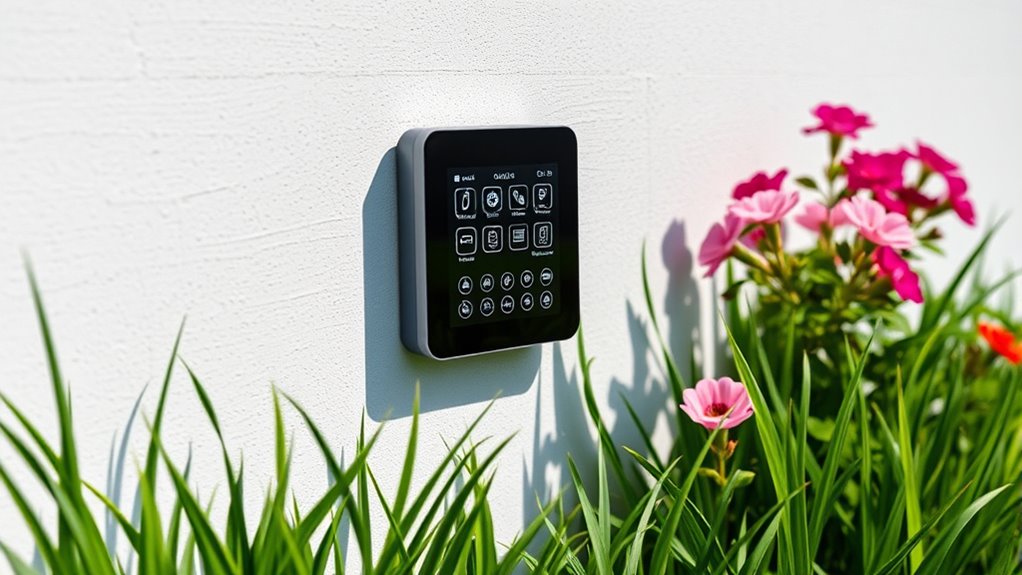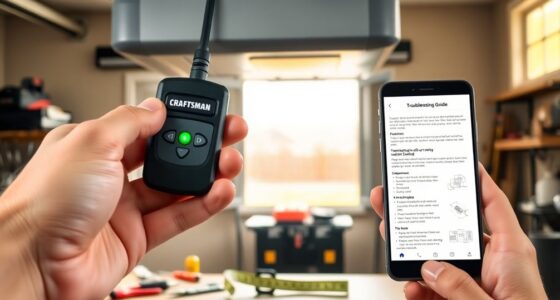Smart sprinkler controllers automatically adjust your watering schedule based on weather conditions and soil moisture. They connect to Wi-Fi, use sensors to detect rain, humidity, and temperature, and access online weather forecasts to optimize watering times. You can control and customize them via smartphone apps, saving water, money, and promoting healthy landscapes. By integrating with other smart home systems, they make outdoor maintenance easier. Keep exploring to learn how to get the most out of your system.
Key Takeaways
- Smart sprinkler controllers use sensors and Wi-Fi to automate watering based on weather and soil conditions.
- They adjust schedules dynamically, reducing water waste and promoting healthy landscapes.
- Integration with weather forecasts and home automation systems enhances scheduling accuracy.
- Features include soil moisture sensors, remote control via apps, and manual override options.
- Proper setup involves Wi-Fi connection, sensor installation, and testing to ensure efficient operation.
How Smart Sprinkler Controllers Work

Smart sprinkler controllers use sensors and internet connectivity to automate watering schedules based on real-time weather data and soil conditions. They gather information from weather sensors that detect rain, humidity, and temperature, ensuring your lawn only gets watered when necessary. The controller then adjusts your watering schedule dynamically, preventing overwatering or underwatering. By connecting to the internet, these devices access up-to-date weather forecasts, further refining the watering plan. You don’t have to manually change schedules; instead, the system reacts automatically to changing conditions. Additionally, smart home integration allows these controllers to work seamlessly with other connected devices, enhancing your overall smart home ecosystem. This integration helps conserve water, saves you money, and keeps your landscape healthy. Overall, smart sprinkler controllers efficiently manage watering schedules by combining local sensor data with online weather information, making your irrigation smarter and more responsive.
Key Features and Benefits
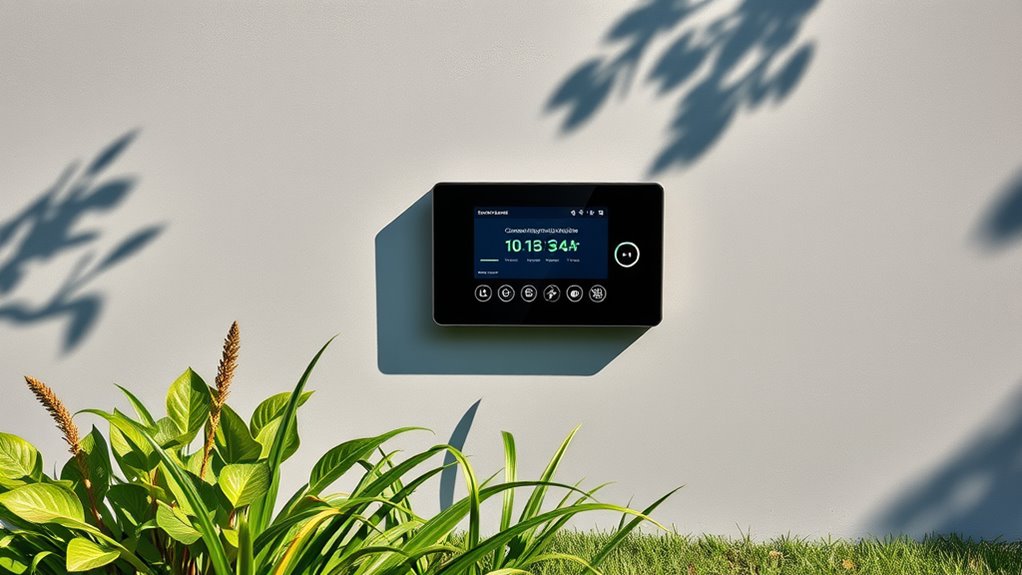
Key features of smart sprinkler controllers enhance their ability to optimize watering while offering convenience and efficiency. They allow you to set flexible watering schedules that adapt to your landscape’s needs, saving water and reducing costs. Weather awareness is a core benefit, as these controllers automatically adjust watering times based on local weather conditions, preventing overwatering during rain or drought. Some models also provide real-time updates and remote control through smartphone apps, giving you full oversight from anywhere. Additionally, smart controllers often include features like soil moisture sensors and zone-specific programming, ensuring each part of your yard receives the right amount of water. These best beaches destinations demonstrate how incorporating advanced technology can promote sustainable tourism practices, which can be applied to smart watering systems as well. Overall, these features help you maintain a healthy landscape while minimizing waste, making your watering routine smarter and more sustainable.
Setting Up and Connecting Your Device
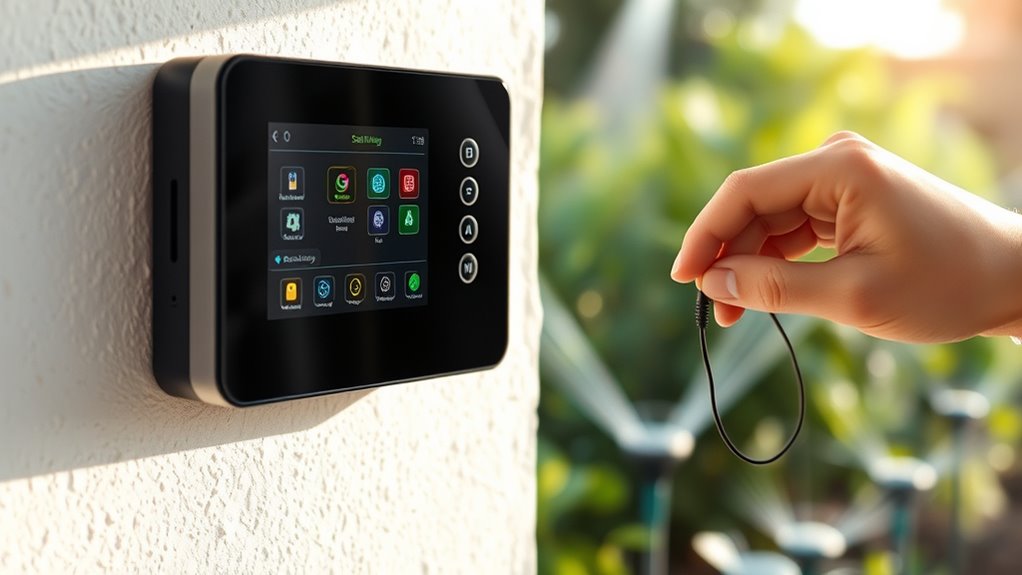
Getting started with your smart sprinkler controller is straightforward, and proper setup guarantees it functions effectively. First, connect the device to your Wi-Fi network following the manufacturer’s instructions. Install rain sensors if required, and ensure they’re properly positioned to detect moisture levels accurately. These sensors help prevent overwatering by signaling the controller to pause watering during rain. Next, configure manual overrides so you can temporarily disable or adjust watering schedules when needed, like during special events or maintenance. Many controllers have a dedicated app or interface to facilitate setup, allowing you to customize schedules, set watering zones, and link rain sensors. Double-check all connections, and run a test cycle to confirm everything operates smoothly. Proper setup ensures your smart sprinkler works efficiently while conserving water. Additionally, understanding the role of moisture sensors can help optimize watering routines and further improve water conservation efforts.
Integrating With Other Smart Home Systems
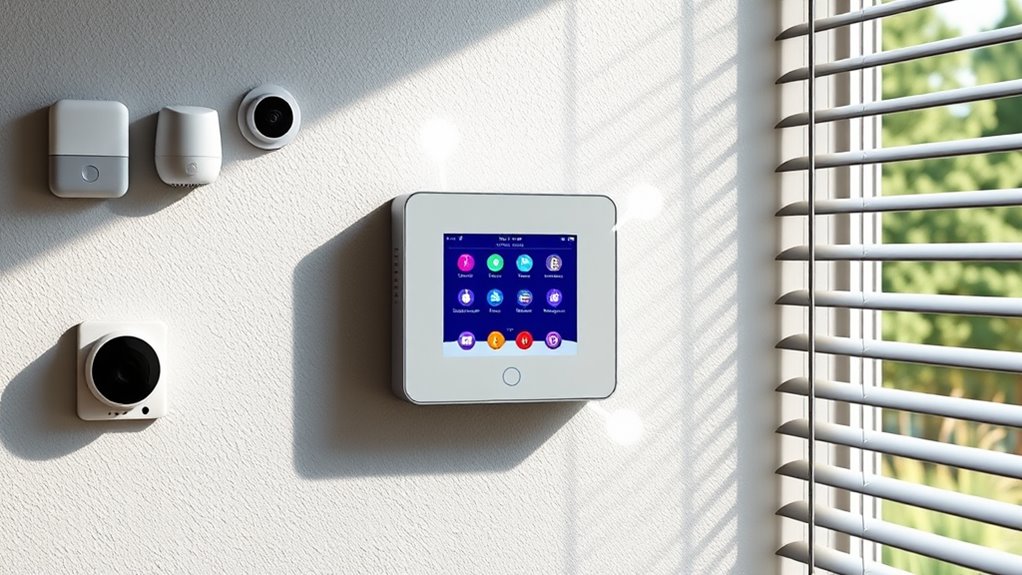
To maximize the efficiency and convenience of your smart sprinkler controller, integrating it with other smart home systems is essential. Weather integration allows your controller to adjust watering schedules automatically based on forecasted rain or humidity levels, preventing overwatering and saving water. By linking your sprinkler system with weather apps or sensors, you ensure your lawn only gets what it needs. Voice control adds another layer of ease; you can simply ask your smart assistant to start or stop watering, change schedules, or check status. This seamless integration streamlines your outdoor maintenance, reduces manual input, and enhances overall home automation. Connecting your sprinkler system with other smart devices makes managing your yard more intuitive, efficient, and responsive to real-time conditions.
Tips for Maximizing Water Efficiency
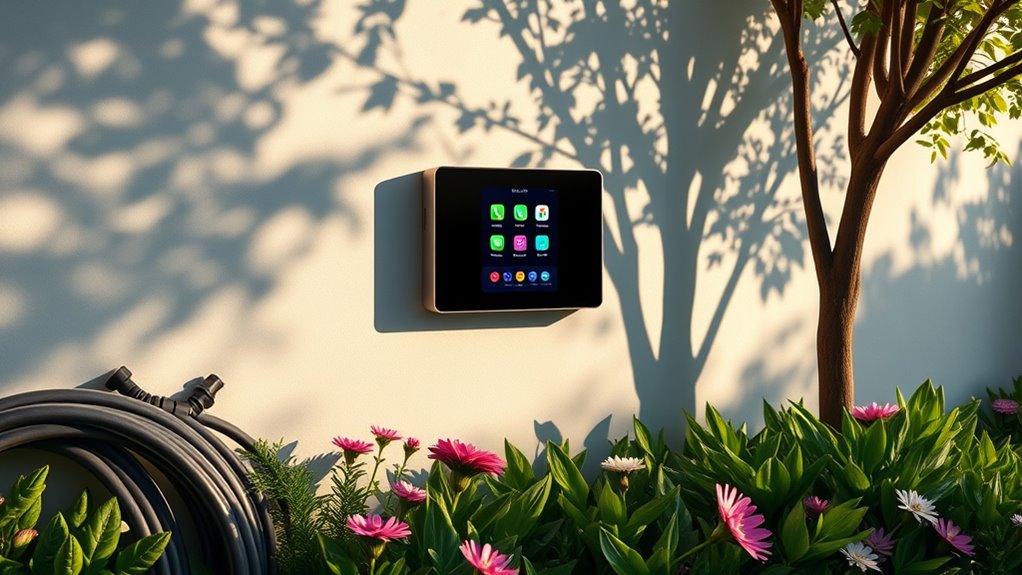
Maximizing water efficiency with your smart sprinkler controller begins with setting it to water during the early morning or late evening hours when evaporation is minimal. Use rain sensors to prevent unnecessary watering after rain, conserving water and lowering costs. Regularly check soil moisture levels with sensors or manual probes to guarantee your lawn isn’t over- or under-watered. Adjust watering schedules based on weather conditions and soil moisture data for ideal results. Avoid watering on windy days, which can cause runoff, and set your controller to skip watering during rain events. By integrating rain sensors and monitoring soil moisture, you’ll guarantee your yard receives just the right amount of water, reducing waste while keeping your landscape healthy. Understanding the refrigeration cycle helps in optimizing system performance and efficiency, which can also contribute to sustainable water and energy use.
Frequently Asked Questions
What Is the Average Lifespan of a Smart Sprinkler Controller?
The average lifespan of a smart sprinkler controller usually ranges from 5 to 10 years, depending on device durability and usage. You’ll want to regularly update your watering schedule and perform maintenance to extend its life. Proper care helps prevent issues, ensuring your smart device continues to operate efficiently. Keep in mind that environmental factors and quality also influence how long your sprinkler controller remains functional.
Are Smart Sprinkler Controllers Suitable for All Types of Lawns?
Is your lawn a sprawling meadow or a modest patch? Smart sprinkler controllers suit many lawns, but consider your lawn size and sprinkler type. They excel in managing water efficiently for small to medium lawns, adapting watering schedules automatically. Large or complex landscapes may need more tailored solutions. By matching your lawn’s unique needs with the controller’s capabilities, you guarantee healthy growth without wasting water.
How Do Weather Forecast Inaccuracies Affect Watering Schedules?
Weather prediction errors can considerably impact your watering schedule, especially if forecast reliability is low. When weather forecasts are inaccurate, your sprinkler system might water too much or too little, wasting water and risking your lawn’s health. You should regularly update your system’s settings or use weather-adaptive features to minimize these issues. Staying aware of forecast reliability helps guarantee your lawn gets the right amount of water, no matter what the weather predicts.
Can Smart Controllers Be Used in Remote or Rural Areas Without Internet?
Imagine managing your irrigation effortlessly, even miles from the nearest Wi-Fi. Turns out, many smart controllers offer offline functionality, letting you program watering schedules without internet. Pair that with solar power, and you gain a reliable, eco-friendly system perfect for remote or rural areas. You won’t need constant connectivity—just set it up once, and enjoy smart watering that adapts to your land’s needs, no matter where you are.
What Are Common Troubleshooting Steps for Connectivity Issues?
If you’re experiencing connectivity issues, start by checking for Wi-Fi interference from other devices or obstacles that might weaken the signal. Make certain your controller has the latest firmware updates, as these often fix bugs and improve performance. Restart your router and sprinkler controller, and verify your Wi-Fi password. If problems persist, move your router closer or consider using a Wi-Fi extender to strengthen the connection.
Conclusion
Now that you understand how smart sprinkler controllers work, you’re ready to take control of your watering world. Think of them as the orchestra conductors of your yard—guiding each drop with precision and care. By harnessing their features and connecting them seamlessly, you’ll transform your garden into a lush paradise while saving water and money. Get ready to let your smart sprinkler system be the steady heartbeat of your outdoor haven.
